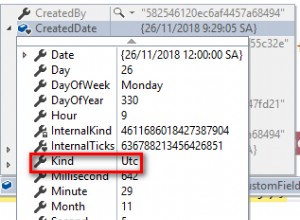Eu implementei um tipo especial para renomear campos arbitrários no MongoDB. Aqui está:
using System.Linq;
using MongoDB.Bson;
using MongoDB.Driver;
namespace DatabaseManagementTools
{
public class MongoDbRefactorer
{
protected MongoDatabase MongoDatabase { get; set; }
public MongoDbRefactorer(MongoDatabase mongoDatabase)
{
MongoDatabase = mongoDatabase;
}
/// <summary>
/// Renames field
/// </summary>
/// <param name="collectionName"></param>
/// <param name="oldFieldNamePath">Supports nested types, even in array. Separate nest level with '$': "FooField1$FooFieldNested$FooFieldNestedNested"</param>
/// <param name="newFieldName">Specify only field name without path to it: "NewFieldName", but not "FooField1$NewFieldName"</param>
public void RenameField(string collectionName, string oldFieldNamePath, string newFieldName)
{
MongoCollection<BsonDocument> mongoCollection = MongoDatabase.GetCollection(collectionName);
MongoCursor<BsonDocument> collectionCursor = mongoCollection.FindAll();
PathSegments pathSegments = new PathSegments(oldFieldNamePath);
// Rename field in each document of collection
foreach (BsonDocument document in collectionCursor)
{
int currentSegmentIndex = 0;
RenameField(document, pathSegments, currentSegmentIndex, newFieldName);
// Now document is modified in memory - replace old document with new in mongo:
mongoCollection.Save(document);
}
}
private void RenameField(BsonValue bsonValue, PathSegments pathSegments, int currentSegmentIndex, string newFieldName)
{
string currentSegmentName = pathSegments[currentSegmentIndex];
if (bsonValue.IsBsonArray)
{
var array = bsonValue.AsBsonArray;
foreach (var arrayElement in array)
{
RenameField(arrayElement.AsBsonDocument, pathSegments, currentSegmentIndex, newFieldName);
}
return;
}
bool isLastNameSegment = pathSegments.Count() == currentSegmentIndex + 1;
if (isLastNameSegment)
{
RenameDirect(bsonValue, currentSegmentName, newFieldName);
return;
}
var innerDocument = bsonValue.AsBsonDocument[currentSegmentName];
RenameField(innerDocument, pathSegments, currentSegmentIndex + 1, newFieldName);
}
private void RenameDirect(BsonValue document, string from, string to)
{
BsonElement bsonValue;
bool elementFound = document.AsBsonDocument.TryGetElement(from, out bsonValue);
if (elementFound)
{
document.AsBsonDocument.Add(to, bsonValue.Value);
document.AsBsonDocument.Remove(from);
}
else
{
// todo: log missing elements
}
}
}
}
E tipo auxiliar para manter os segmentos do caminho:
using System;
using System.Collections;
using System.Collections.Generic;
using System.Linq;
namespace DatabaseManagementTools
{
public class PathSegments : IEnumerable<string>
{
private List<string> Segments { get; set; }
/// <summary>
/// Split segment levels with '$'. For example: "School$CustomCodes"
/// </summary>
/// <param name="pathToParse"></param>
public PathSegments(string pathToParse)
{
Segments = ParseSegments(pathToParse);
}
private static List<string> ParseSegments(string oldFieldNamePath)
{
string[] pathSegments = oldFieldNamePath.Trim(new []{'$', ' '})
.Split(new [] {'$'}, StringSplitOptions.RemoveEmptyEntries);
return pathSegments.ToList();
}
public IEnumerator<string> GetEnumerator()
{
return Segments.GetEnumerator();
}
IEnumerator IEnumerable.GetEnumerator()
{
return GetEnumerator();
}
public string this[int index]
{
get { return Segments[index]; }
}
}
}
Para separar os níveis de aninhamento eu uso o sinal '$' - o único sinal que é proibido para nomes de coleção no mongo.O uso pode ser algo assim:
MongoDbRefactorer mongoDbRefactorer = new MongoDbRefactorer(Mongo.Database);
mongoDbRefactorer.RenameField("schools", "FoobarTypesCustom$FoobarDefaultName", "FoobarName");
Este código será encontrado na coleção
schools FoobarTypesCustom propriedade. Pode ser um tipo tão complexo como array. Em seguida, encontrará todos os FoobarDefaultName propriedades (se FoobarTypesCustom é array então ele irá iterar através dele) e renomeá-lo para FoobarName . Níveis de aninhamento e número de matrizes aninhadas não importa. 



